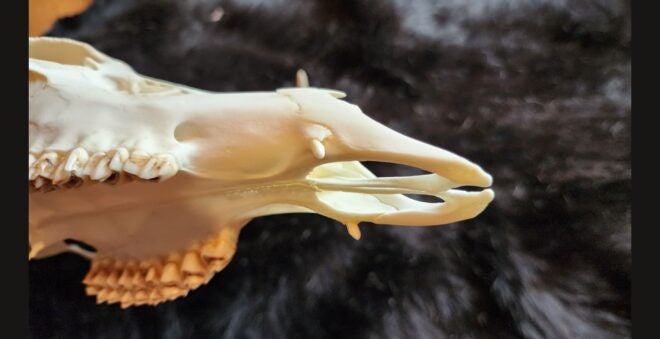Whitetail Deer Fangs?! What Are They & How Do They Occur?…
Megan Plete Postol 02.29.24

Brian Rush of Rush Custom Callers was preparing a buck for a European mount for a local hunter and friend last fall when he discovered something strange. Hidden from plain view underneath the gums of that buck were upper canine teeth. Whitetail deer with front canine teeth sound like an urban legend, but once in a while anomalies occur. Some people refer to this rare occurrence as whitetail deer fangs. Occasionally, a hunter or taxidermist will uncover upper canine teeth, but usually only after skinning. These are in addition to the typical eight lower teeth that are present in all normal whitetail deer, six being incisors and the outermost two canines. While the presence of upper canine teeth are rare, what is more rare is when they poke through the gumline. Because of that, they are seldom revealed until the deer is being processed for taxidermy.
Whitetail Deer Coverage on AllOutdoor
- Home on the Range #056: Where Have All the Whitetail Deer Gone?…
- MN Whitetail Deer Hunter Bags Trophy Buck and an Alligator?!
- The Suicide Doe – This Whitetail Deer’s Time had Come
- Montana Decoy Deer Rump Whitetail Deer Decoy Review
How Common Are Upper Canine Teeth – Whitetail Deer Fangs?
The available research on the presence of upper canines in deer is quite limited, but from what is available, it is estimated that the quirk occurs in only one in every 10,000 to 20,000 deer. Some research published by the National Deer Association suggests that whitetails in Central America have a higher prevalence rate of upper canines, with the frequency increasing further South. It is also unclear if upper canines occur more frequently in bucks than does, simply because does are rarely processed for mounting, so the opportunity for discovery is automatically narrower.

A report prepared by Michigan Department of Conservation (the predecessor of the Department of Natural Resources) staffer Lawrence Ryel from a few decades ago states that upper canines have been identified in whitetails from as far north as Saskatchewan and South to Central America. Lawrence cited reports of upper canines from multiple states: upper canines were found in 25 of 18,000 deer, roughly 0.14 percent, in New York, in zero of about 10,000 deer in Wisconsin, in 4 of 166 deer roughly 2.4 percent, from Michigan’s Upper Peninsula, in 1 of 134 deer roughly .07 percent, from Michigan’s Lower Peninsula, and in 4 of 95 deer roughly 4.2 percent, from Florida.
Whitetail Deer Fangs – Passed Down From Generations
Upper canine teeth in modern whitetail deer are thought to be a leftover evolutionary trait from their ancestors. Both ancient whitetail and mule deer had long, sharp, curved fangs, or tusks, instead of antlers. As generations adapted and progressed, the fanged teeth grew shorter, and the antlers grew longer. Muntjacs, the oldest known species of deer, still possess both fangs and antlers. Other modern relatives of whitetail deer that have present upper canines are elk, musk deer, Chinese water deer, sambar, and tufted deer. Historically, upper canine teeth were present in both buck and doe of ancient deer species, so it is very likely that the rarity still occurs in equal distribution. Of the deer surveyed for the report, at least one was a doe, and that was recorded in Florida.